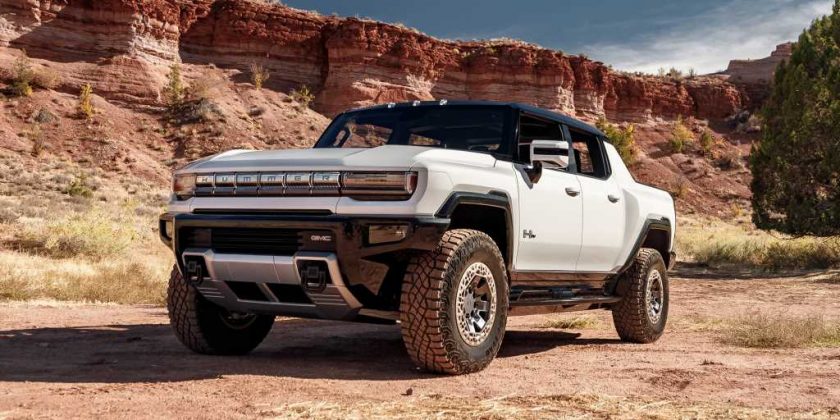General Motors is upping its commitment to electric vehicles. CEO Mary Barra now says GM will offer 30 all-electric vehicles globally by the end of 2025, with four out of every 10 vehicles offered in the U.S. being powered purely by electricity. The Detroit-based company is increasing its planned EV budget from $20 billion to $27 billion, and recently committed to bolstering its engineering ranks to maintain a fast and furious pace for development.
The automaker is still a bit giddy it created the 2022 GMC Hummer EV, a full-size electric pickup truck, in 26 months. And the 2023 Cadillac Lyriq electric midsize SUV is also being prepared for production at GM’s Spring Hill plant in Tennessee, which will be retooled to make electric vehicles.
The GMC, Cadillac, Buick and Chevrolet brands all have electric vehicles in the works. Most will use GM’s new electric vehicle architecture and its Ultium battery system, which GM now says will offer up to 450 miles on a single charge.
In addition, the development schedules for 12 vehicle programs have been moved up, including the GMC Hummer full-size electric pickup, the Hummer SUV (which just leaked), and two other GMCs; four Chevrolet EVs including a full-size pickup truck and a compact crossover; and four Cadillacs including the Lyriq midsize crossover. The Lyriq will now arrive nine months early in the first quarter of 2022. The timeline for two Buick crossovers has not been pulled ahead.
GM CEO Mary Barra told investors at a Barclay Global Automotive Conference that more than half of GM’s total capital spending and product-development team will be devoted to electric and autonomous vehicles. That is putting money where your mouth is.
GM Hiring 300 Engineers
Regarding the staffing commitment, GM previously said it is hiring another 3,000 employees, mostly engineers and software developers, with some design and IT personnel tossed in. The goal is to have all hiring done by the end of the first quarter of 2021. Many will be free to work from home, wherever that is, to allow GM to go after the best and brightest, said Ken Morris, vice president of electric and autonomous vehicles.
The current-gen electrical architecture, which is based on GM’s Ultium battery system, is essentially developed and complete, Morris said. That means creating a new vehicle in as little as 18 months is now the rule, not the exception. It is the new standard going forward, with so much of the underlying development having been front-loaded. He said it means the first test vehicles coming off the line feel like production vehicles, ready to hit the real world and be verified.
Ultium Batteries in 19 Flavors
The Ultium battery system can be configured 19 different ways to accommodate front-, rear-, and all-wheel drive as well as performance future vehicles in all sizes and segments. Key to continued growth is developing further software, says GM President Mark Reuss. “We want to advance entire EV portfolio which is where we need the additional horsepower of 3,000 more engineers,” said Morris. Battery production at the Lordstown plant will begin in the first quarter of 2021 before ramping up as it supplies the Hummer and Lyriq, vehicles which will initially have low volumes. The Hummer truck will be available in just one—now sold out—fully loaded configuration for its initial model year.
At the same time, GM is working on the second-generation Ultium chemistry that is projected to double the energy density while cutting the cost in half to bring cost close to parity with gasoline-powered vehicles. Prototypes are being tested now and this second-gen tech is expected mid-decade, at which point we’ll find out if it lives up to its lofty promises.
See all 76 photos
2022 Chevrolet Bolt EUV Coming Next Year
Morris said GM will show the new 2022 Chevrolet Bolt EUV, a taller version of the Chevrolet Bolt EV, early next year and that it will go into production next summer. It will be built at the Orion assembly plant in Michigan. The Bolt EUV is on the same original electrical architecture as the Bolt; it does not use the Ultium system. But it will have the enhanced Super Cruise hands-free highway driving-assistance system.
Most of the work done by the newly hired engineers will be EV-specific, but they will also work on autonomous-vehicle technology and infotainment connectivity as screens continue to dominate modern cockpits.
Morris said GM expects the industry will hit an inflection point in the middle of the decade with customer adoption of mainstream electric vehicles. GM wants to ensure it is on the leading edge with mass-production and mainstream vehicles available. “We want to be ready. If we miss the opportunity, it’s hard to catch up.”
This story was originally published under the headline “GM Says 18-Month EV Development Is Now Its New Normal” on November 9. It has been updated to reflect GM’s latest announcements regarding its EV strategy.
Source: Read Full Article
